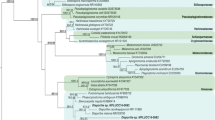Abstract
The wide potential of resin acids as bioactive agents gave rise to a growing effort in the search for new applications of the natural forms and their derivatives. In some of these compounds, the antimicrobial activity is associated to the presence in the molecules of functional groups such as the hydroxyl, aldehyde, and ketone or to their cis or trans configurations. The resin acid family covers a spectrum of antimicrobial activities against several microorganisms, from bacteria to fungi, in which the mode of action was studied by electron microscopy. The morphological alterations are consistent with an unspecific mode of action causing inhibition of the fungal growth or damaging the fungal cells in parallel with a mechanism of resistance based on the retention of the compound by the lipid accumulation. The sterol composition of phytopathogenic fungi Botrytis cinerea and Lophodermium seditiosum treated with methyl cis-7-oxo-deisopropyldehydroabietate revealed the presence of ergosterol (M+ 396) and dihydroergosterol (M+ 398) in both cultures showing that this compound did not interfere with the ergosterol metabolic pathway of both fungi.




Similar content being viewed by others
References
Bohlmann J, Croteau R (1999) Diversity and variability of terpenoid defences in conifers: molecular genetics, biochemistry and evolution of the terpene synthase gene family in grand fir (Abies grandis). In: Chadwick DJ, Goode JA (eds) Insect plant interactions and induced plant defence. Wiley, West Sussex, UK, pp 132–146
Borglin S (1947) Naval stores chemicals in the disinfectant field. Soap. Sanit Chem, pp 23, 12, 147, 149, 169
Carman RM, Marty RA (1970) Diterpenoids. XXIV. Agathis species of North Queensland. Two new resin acids. Aust J Chem 23:1457–1464
Croteau R, Johnson MA (1985) Biosynthesis of terpenoid wood extractives. In: Higuichi T (ed) Biosynthesis and biodegradation of wood components. pp 379–439
Fonseca T, Gigante B, Marques MM, Gilchrist LT, Clercq E (2004) Synthesis and antiviral evaluation of benzimidazoles, quinoxalines and indoles from dehydroabietic acid. Bioorg Med Chem 12:103–112
Franich RA, Gadgil PD, Shain L (1983) Fungistatic effects of Pinus radiata needle epicuticular fatty and resin acids on Dothistroma pini. Physiol Plant Pathol 23:183–195
Fukui H, Koshimizu K, Egawa H (1978) A new diterpene with antimicrobial activity from Chamaecyparis pisifera Endle. Agric Biol Chem 42:1419–1423
Gigante B, Silva AM, Marcelo Curto MJ, Savluchinske Feio S, Roseiro JC, Reis VR (2002) Structural effects on the bioactivity of dehydroabietic acid derivatives. Planta Med 68:680–684
Gigante B, Santos C, Silva AM, Nascimento JSM, Pinto E, Pedro M, Cerqueira F, Pinto MM, Duarte PM, Laires A, Rueff J, Gonçalves J, Pegado IM, Valdeira LM (2003) Catechols from abietic acid: synthesis and evaluation as bioactive compounds. Bioorg Med Chem 11:1631–1638
Gijzen M, Lewinsohn E, Savage TJ, Croteau RB (1993) Conifer monoterpenes: biochemistry and bark beetle chemical ecology. In: Teranishi R, Buttery RG, Sugisawa H (eds) Bioactive volatile compounds from plants. Am Chemical Society, Washington, DC, pp 822
Henriks ML, Ekman R, Von Weissenberg K (1979) Bioassay of some resin and fatty acids with Fomes annosus. Acta Acad Aboensis 39B:1–7
Jonnessen VL, Stern ES (1978) US Patent 4128543: Chem Abstr 90, 76409
Kobayashi K, Nishino C, Fukushima M, Shiabara Y, Kodama M (1988) Antibacterial activity of pisiferic acid and its derivatives against gram-negative and gram-positive bacteria. Agric Biol Chem 52:77–83
Kopper BJ, Illman BL, Kersten PJ, Klepzig KD, Raffa KF (2005) Effects of diterpene acids on components of a conifer bark beetle–fungal interaction. Environ Entomol 34:486–493
Mensah AY, Houghton PJ, Bloomfield S, Vlietink A, Berghe DV (2000) Known and novel terpenes from Buddleja globosa displaying selective antifungal activity against dermatophytes. J Nat Prod 63:1210–1213
Moujir L, Gutierrez-Navajo A (1996) Bioactive diterpenoids isolated from Salvia mellifera. Phytother Res 10:172–174
Muftic M (1968) Dehydroabietylguanidine (DAG) ein Breitspektriges Semisynthetisches Antibiotikum mit besonderer Wirkung gegen Mycobacterium. Z F Tuberk 129:305–310
Muftic M (1970) Essay on antibiotic properties of abietyl compounds. Q J Crude Drug Res 10:1601–1607
Mutton DB (1962) Wood resin. In: Hillispp WE (ed) Wood extractives. Academic, New York, pp 331–363
Norin T (1972) Some aspects of the chemistry of the order pinales. Phytochemistry 11:1231–1242
Phillips MA, Croteau R (1999) Resin based defences in conifers. Trends Plant Sci 4:184–190
San Feliciano A, Gordaliza M, Salinero M, Del Corral MJ (1993) Abietane acids: sources, biological activities, and therapeutic uses. Planta Med 5:485–490
Savluchinske Feio S, Roseiro JC, Gigante B, Marcelo Curto MJ (1997) Antimicrobial activity of diterpene resin acid derivatives. J Microbiol Methods 28:201–206
Savluchinske Feio S, Roseiro JC, Gigante B, Marcelo Curto MJ (1999) Antimicrobial activity of diterpene resin acid derivatives. J Microbiol Methods 35:201–206
Savluchinske Feio S, Franca S, Silva AM, Gigante B, Roseiro JC, Marcelo Curto MJ (2002) Antimicrobial activity of methyl cis-7-oxo deisopropyldehydroabietate on Botrytis cinerea and Lophodermium seditiosum. Morphological studies by TEM. J Appl Microbiol 93:765–771
Smith E, Williamson E, Zloh M, Gibbons S (2005) Isopimaric acid from Pinus nigra shows activity against multidrug-resistant and EMRSA strains of Staphylococcus aureus. Phytother Res 19:538–542
Soderberg TA, Holm S, Gref R, Hallmans G (1991) Antibacterial effects of zinc oxide, rosin and resin acids with special reference to their interactions. Scand J Plast Reconstr Surg Hand Surg 25:19–24
Trapp S, Croteau R (2001) Defensive resin biosynthesis in conifers. Ann Rev Plant Physiol Plant Mol Biol 52:689–724
Ulubelen A, Oksuz S, Kolak U, Bozok-Johansson C, Voelter W (2000) Antibacterial diterpenes from the roots of Salvia viridis. Planta Med 66:458–462
Vargas I, Sanz I, Moya P, Prima-Yufera E (1999) Antimicrobial and antioxidant compounds in the nonvolatile fraction of expressed orange essential oil. J Food Prot 62:929–932
Author information
Authors and Affiliations
Corresponding author
Rights and permissions
About this article
Cite this article
Savluchinske-Feio, S., Curto, M.J.M., Gigante, B. et al. Antimicrobial activity of resin acid derivatives. Appl Microbiol Biotechnol 72, 430–436 (2006). https://doi.org/10.1007/s00253-006-0517-0
Received:
Revised:
Accepted:
Published:
Issue Date:
DOI: https://doi.org/10.1007/s00253-006-0517-0




